Work, Energy and Power | Physics - Long Questions and Answer | 11th Physics : UNIT 4 : Work, Energy and Power
Chapter: 11th Physics : UNIT 4 : Work, Energy and Power
Long Questions and Answer
Work, Energy and Power | Physics
Long Answer Questions
1. Explain with graphs the difference between work done by a constant force and by a variable force.
Work
done by a constance force :
●
When a constant force F acts a body the small workdone (dw) by the force in
producing a small displacement dr is given by the relation.
dw
= (Fcosθ) dr ………….. (1)
●
The total work done in producing a displacement from initial position ri to
final position rf is
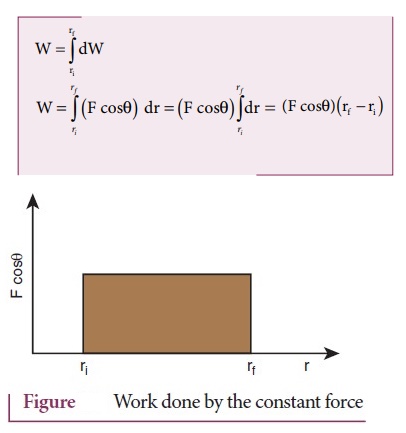
●
The graphical representation of the work done by a constant force is shown in
figure. The area under the graph shows the work done by the constant force.
Work
done by a variable force
●
When the component of a variable force F acts on a body, the small work done
(dw) by the forces in producing a small displacement dr is given by the relation.
dw = (F cosθ) dr
Where
F and θ are variables
●
The total work done for a displacement from initial position ri to
final position rf is given by the relation,

●
A graphical representation of the work done by a variable force is shown in
figure.
●
The area under the graph is the work done by the variable force.
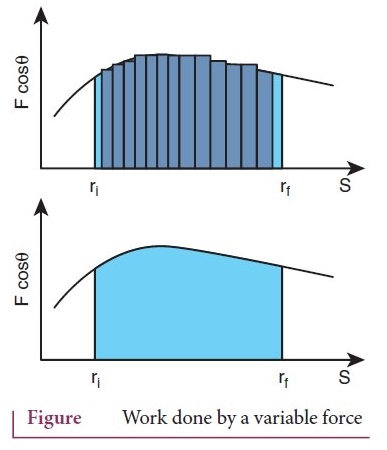
2. State and explain work energy principle. Mention any three examples for it.
Statement
:-
●
It states that the work done by the force on the body changes the kinetic
energy of the body. This called work - kinetic energy theorem.
●
Work and energy are equivalents. This is true in the case of kinetic energy
also.
●
To prove this, let us consider a body of mass at rest on friction less
horizontal surface.
●
The work done (w) by the constant force (F) for a displacement (s) in the same
direction is.
W
= Fs ……………. (1)
●
The constant force is given by the equation
F
= ma ……………… (2)
●
The third equation of motion can be written as
v2
= u2 + 2as
a
= [ v2 - u2 ] / 2s
●
Substituting for 'a' in equation (2)
F
= m ( [v2 − u2 ] / 2s)
●
Substituting equation (3) in (1)
W
= m ([v2 / 2s] s) – m ([u2 / 2s] s)
W
= 1/2 mv2 – 1/2 mu2 ………… (4)
The
expression for kinetic energy
●
The term (1/2 mv2) in the above equation is the kinetic energy of
the body of mass (m) moving with velocity (v)
K.E
= 1/2 mv2 ………….. (5)
●
Kinetic energy of the body is always positive.
●
From equation (4) and (5)
KE
= 1/2 mv2 − 1/2 mv2 ……………….(6)
Thus
W = ∆KE
The
expression on the right hand side (RHS) of equation (6) is change in kinetic
energy of the body. The work - kinetic energy implies the following
1.
If the work done by the force on the body is positive, then its kinetic energy
increases.
2.
If the work done by the force on the body is negative, then kinetic energy
decreases.
3.
If there is no work done by the force on the body then there is no change in
its kinetic energy, which means that the body has moved at constant speed
provided its mass remains constant.
3. Arrive at an expression for power and velocity. Give some examples for the same.
●
The work done by a force ![]() for a displacement d
for a displacement d![]() is
is
 …………(1)
…………(1)
●
Left hand side of the equation (1) can be written as
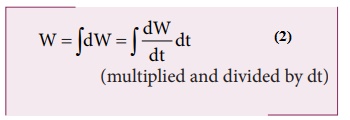
W
= ʃ dw = ʃ dw/dt dt …………….. (2)
(Multiplied and divided by dt)
●
Since, velocity is 
●
Right hand side of the equation (1) can be written as

●
Substituting equation (2) and (3) in equaiton (1) we get,
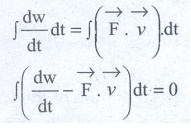
………..(3)
●
The relation is true for any arbitrary value of dt. This implies that the term
with in the bracket must be equal to zero,
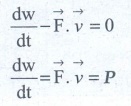
4. Arrive at an expression for elastic collision in 1 Dimension and discuss various cases.
●
Consider two elastic bodies of masses m1 and m2 moving in
a straight line (along positive x direction) on a friction less horizontal
surface as shown in figure.

●
The mass m1 moves faster than mass m2 (i.e. u1
> u2). For elastic collision, the total linear momentum and
kinetic energies of the two bodies before and after collision must remain the
same.

●
From the law of conservation of linear momentum
Total
momentum before collision (pi) = Total momentum after collision (pf)
●
m1u1+ m2u2 = m1v1+
m2v2 …………. (1)
m1(u1
- v1) = m2 (v2 - u2) ……….. (2)
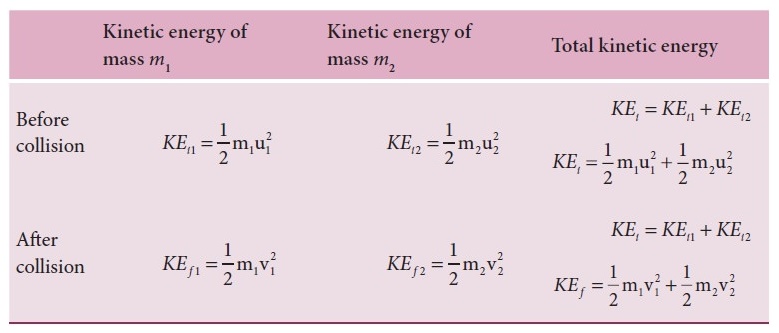
●
For elastic collision
Total
kinetic energy before collision KEi = Total kinetic energy after
collision KEf
1/2
m1u12 + 1/2 m2u12
= 1/2 m1v12 + 1/2 m1v22
………(3)
m1(u12
− v12) = m2 (v22 − u22
)
●
Using formula a2 − b2 = (a+b) (a-b) we can rewrite above
equation as,
m1
(u1+v1) (u1−v1) = m2 (v2+u2)
(v2−u2) ………….. (4)
Dividing
(4) by (2) gives,
[
m1 (u1+v1)(u1−v1) ] / [ m1
(u1−v1) ] = [ m2 (v2+u2)(v2-u2)
] / [ m2(v2-u2) ]
ul
+ vl = v2 - u2 ………… (5)
Rearranging
(5) we get,
u1+u2
= v2 - v1
Equation
(5) can be re written as,
u1−u2
= − (v1−v2)
●
For any elastic head on collision, the relative speed of the two elastic bodies
after the collision has the same magnitude as before collision but in opposite
direction.
Rewritting
the above equation for and v1 and v2
v1
= v2 + u2 − u1 …………..(6)
(or)
v2 = u1 + v1 − u2 ……... (7)
To
find the velocities of v1 and v2
Substituting
equation (7) in equation (2) gives the velocity of mass m1 as
m1
(u1- v1) = m2 (u1 + v1 -
u2 - u2)
m1
(u1- v1) = m2 (u1 + v1 -
2u2 )
m1
u1- m1v1 = m2u1 + m2v1
- 2m2 u2
m1
u1 - m2 u1 + 2m2u2 = m1v1
+ m2v1
(m1
- m2 )u1 + 2m2u2 = (m1 +
m2) v1
v1
= (m1-m2 / m1+m2) u1
+ (2m2 / m1+m2) u2 ………(8)
●
Similarly by substituting (6) in equation (2) (or) substituting equation (8) in
equation (7) we get the final velocity of m2 as,
v2
= (2m1 / m1+m2 ) u1 + (m2
- m1 / m1 + m2) u2 ………(9)
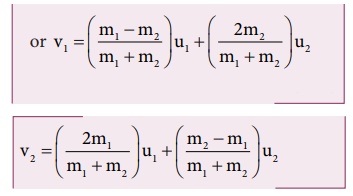
Case
: I
When bodies has the same mass
(i.e.)
m1 = m2
Equation
(8) ⇒ v1 = (0) u1
+ (2m2 / 2m2) u2
v1
= u2 ………………(10)
Equation
9 ⇒ v2 = (2m1
/ 2m1) u1 + (0)u2
V2
= u1 ……… (11)
The
equation (10) and (11) show that in one dimensional elastic collision, when two
bodies of equal mass collide after the collision their velocities are
exchanged.
Case
2:
When bodies have the same mass (Q) m1 = m2 and second
body (usually called target) is at rest (u2 = 0)
By
substituting m1 = m2 and u2 = 0 in equations
(8) and (9) we get,
from
equation (8) ⇒ v1
= 0 ……….. (12)
from
equation (9) ⇒ v2=
u1 ……….. (13)
Equation
(12) and (13) shows that when the first body comes to rest the second body
moves with initial velocity of the first body.
Case
3:
The first body is very much lighter than the second body.
(m1 << m2 ; m1 / m2 << 1) then the ratio m1 / m2 = 0 and also if the target is at rest (u2 = 0). Dividing numerator and denominator of equations (8) by m2 we get,

v1
= − u1 ……………..(14)
●
Similiarly dividing numerator and denominator of equation (9) by m2
we get,
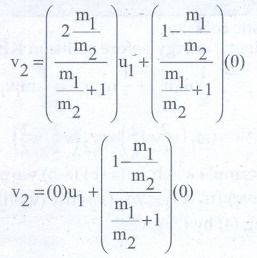
v2
= 0 ………..(15)
●
The equation (14) implies that the first body which is lighter returns back
(rebounds) in the opposite direction with the same initial velocity as it has a
negative sign. The equation (15) implies that the second body which is heavier
mass continues to remain at rest even after collision. For example if a ball is
thrown at a fixed wall, the ball will bounce back from the wall with the same
velocity with which it was thrown but in opposite direction.
Case
4:
The second body is very much lighter then the first body (m2 <<
m1, m2/m1<<1) then the ratio m2/m1
= 0 and also if the target is at rest (u2 = 0).
●
Dividing numerator and denominator of equation (8) by m1 we get,
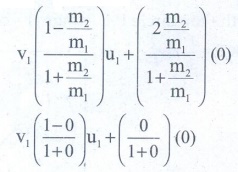
v1
= u1 ……………(16)
●
Similarly dividing numerator and denominator of equation (13) by m1
we get,
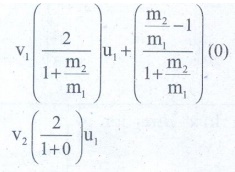
v2
= u2 ……………(17)
●
The equation (16) implies that the first body which is heavier continues to
move with the same initial velocity.
●
The equation (17) suggests that the second body which is lighter will move
twice the initial velocity of the first body. It means that the lighter body is
thrown away from the point collision.
5. What is inelastic collision? In which way it is different from elastic collision. Mention few examples in day to day life for inelastic collision.
●
In a collision the total initial kinetic energy of the bodies (before
collision) is not equal to the total final kinetic energy of the bodies (after collision)
then, it is called as in elastic collision.
i.e.
Total kinetic energy before collision ≠ Total kinetic energy after collision
●
Total kinetic energy after collision − Total kinetic energy before collision =
Loss in energy during collision = ∆Q
●
Even though kinetic energy is not conserved but the total energy is conserved.
●
This is because the total energy contains the kinetic energy term and also a
term ∆Q, which includes all the losses that take place during collision.
●
Note that loss in kinetic energy during collision is transformed to another
form of energy like, sound thermal etc.
●
Further, if the two colliding bodies stick together after collision such
collisions are known as completely in elastic collision (or) perfectly in elastic
collision.
●
For example when a clay putty is thrown on a moving vehicle, the clay putty (or
bubble gum) sticks to the moving vehicle and they move together with the same
velocity.
Related Topics